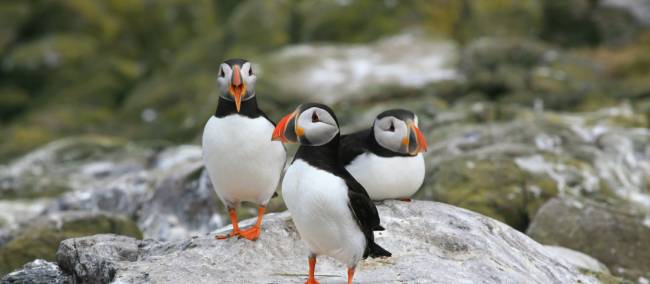
A puff of Puffins | John Millen
Blog home / Highlights of Walking in Northumberland
Northumberland, with its rugged coastline, serene woodlands, and pristine beaches, is a haven for walkers and wildlife enthusiasts alike.
Among its many treasures, the Farne Islands and the Lindisfarne National Nature Reserve stand out as must-visit destinations, offering unparalleled opportunities to connect with nature and witness some of the UK's most remarkable wildlife spectacles.
A Wildlife Wonderland in The Farne Islands
Declared by Sir David Attenborough as his favourite place to see nature in the UK, the Farne Islands are a true gem of Northumberland. This group of rocky islets is home to the largest colony of puffins in the UK, where these colourful seabirds return each year to reunite with their lifelong mates. Visitors can spot around 23 different bird species here, including razorbills, guillemots, and eider ducks.
For the best experience, plan your visit between mid-April and late July, when the islands are teeming with life. During this period, you can also catch sight of adorable baby puffins, affectionately known as ‘pufflings,’ on a boat trip in June.
Autumn brings another spectacular sight: up to 3,000 fluffy white seal pups lining the beaches. The Farne Islands boast England’s largest breeding colony of Grey Seals, and these playful creatures can often be seen bobbing in the water, alongside occasional sightings of dolphins and porpoises.
Witness the Holy Island on Lindisfarne National Nature Reserve
Just a short journey from the Farnes lies the Lindisfarne National Nature Reserve, a sanctuary rated as one of Europe’s best sites for waders and wildfowl. The reserve’s diverse habitats, from tidal mudflats to salt marshes, attract an impressive array of birdlife.
Holy Island is a beautiful place and the priory ruins, dating back 1400 years, are atmospheric. There is a castle on the island and until 1893 this served as a defensive garrison. In 1901 It became a private residence redesigned by Edwin Lutyens. If the tide permits, you can walk the traditional pilgrim’s route across the sands at low-tide.
One of the reserve’s most iconic residents is the curlew, the UK’s largest wading bird. With their haunting call and elegant, stilt-like legs, curlews are a striking presence along the Northumberland coast. Visitors may also encounter ospreys, marsh harriers, and brent geese migrating from Svalbard.
Walk the Ancient Hadrian's Wall
No visit to Northumberland is complete without exploring the world-famous
Hadrian’s Wall. Stretching across the countryside, this ancient Roman fortification offers walkers a journey through time, with well-preserved ruins, milecastles, and forts scattered along its path.
The surrounding landscapes, from rolling hills to dramatic escarpments, provide a stunning backdrop to this UNESCO World Heritage Site, making it a must-visit for history buffs and hiking enthusiasts alike.
More to Explore Along the Northumberland Coast
Beyond the Farnes and Lindisfarne, Northumberland’s coastal landscapes offer a rich tapestry of habitats. Woodland trails, wildflower meadows, and sandy beaches provide the perfect backdrop for a peaceful walking holiday. Keep your eyes peeled for the incredible diversity of flora and fauna that call this region home.
For history enthusiasts, Northumberland’s ancient castles add a touch of magic to its walking routes. Stroll along coastal paths to the iconic Bamburgh Castle, perched dramatically above golden sands, or explore the ruins of Dunstanburgh Castle, accessible via a scenic walk from Craster. The enchanting Lindisfarne Castle on Holy Island, surrounded by tidal waters, offers another unforgettable destination for walkers. Each castle tells a story of the region’s rich heritage, blending natural beauty with historical intrigue.
For nature enthusiasts, every season brings something special. From the bustling seabird colonies of summer to the serene beauty of autumn’s seal pups and migrating geese, Northumberland never fails to enchant.
Tips for Your Visit to Northumberland
- Plan your timing: Visit mid-April to late July for seabirds and puffins, or October for seal pups.
- Take a boat trip: On our Walk Northumberland Coast Path & Lindisfarne holiday, we recommend taking a boat trip out to the Farne Islands on Day 4.
- Stay aware of the tides: When visiting Lindisfarne (Holy Island), check Holy Island tide schedules to ensure safe crossing.
- Pack binoculars: A good pair of binoculars is essential to fully appreciate the diverse birdlife.
Northumberland’s natural beauty and extraordinary wildlife make it an unforgettable destination. Whether you’re strolling along its windswept beaches or marvelling at the vibrant puffin colonies, this region invites you to immerse yourself in its wild wonders. If you want to explore this region for yourself, take a look at our range of
Walking Holidays in Northumberland.